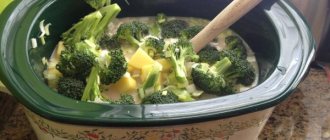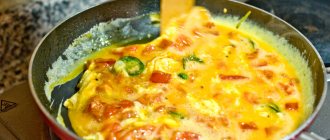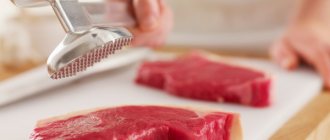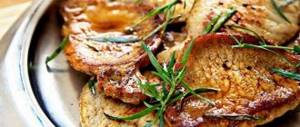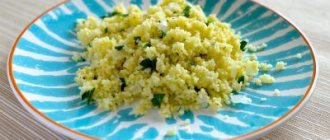Home cooking vs store bought khinkali
It is traditionally believed that store-bought products are inferior in quality to those prepared with love at home. The modern pace of life and busy work do not always allow you to devote time to culinary masterpieces. Under any circumstances, the method of cooking khinkali is almost the same for both store-bought and home-made semi-finished products.
Store-bought versions are of very decent quality, but often contain less minced meat and their dough is thicker. Because of this, they cook 2-3 minutes longer than homemade ones.
How to cook khinkali in the microwave
There is a microwave in almost every kitchen; you can also cook khinkali in this universal device. To do this you need:
- Take a deep plate (suitable for microwave temperature) or a saucepan.
- Place the khinkali into the bowl, carefully, one piece at a time, and carefully ensure that they do not touch each other too much.
- Pour a glass of water over the khinkali and add some spices.
- Cover everything with a lid and leave on full power for 10 minutes.
Traditional preparation
For Georgians, the only correct way to prepare their favorite dish is to cook khinkali in boiling water. There are many popular videos on the Internet about traditional Tbilisi khinkali, where there are huge vats with national dishes boiling in them. At home, under normal conditions, you can use a saucepan for cooking.
It is desirable that it be capacious and roomy. Step-by-step instructions on how to properly cook khinkali in a pan:
- The widest possible container is selected so that during the cooking process the khinkali can float in it at a short distance from each other;
- The pan is filled 2/3 with water and placed on maximum heat;
- Water is added to taste, which gives the dough of the finished dish greater elasticity;
- For aroma, add bay leaf and a few peas of allspice to the water;
- Khinkali is carefully lowered into boiling water one piece at a time, holding them by the tails;
- An important point is that you need to stir during the cooking process to prevent sticking. The moment of readiness is awaited;
- After 10-15 minutes, the khinkal should float to the surface. This means they are cooked;
- Using a slotted spoon (or wooden spatula), the finished khinkali are carefully removed from the pan and laid out on a flat dish.
The taste of finished khinkali is not affected by the fact whether they were fresh or frozen before going into the pan. The answer to the question of how long to cook frozen khinkaliprost: the cooking time is the same - 10-15 minutes after boiling and rising.
How to cook khinkali in a pressure cooker
A manto cooker is a specialized steamer designed for preparing Asian dishes manti and oram. To prepare khinkali in this specialized vessel, you need to follow the following algorithm:
- Pour water into the bottom of the steamer and bring to a boil.
- The mugs of the device must be lubricated with sunflower oil.
- Place the prepared products on these mugs at approximately the same distance from each other.
- Place the mugs at the top of the pressure cooker and connect both parts.
- Cook for 25-30 minutes. When finished, remove the products and place on a plate.
That's all, cooking in a pressure cooker is a fairly simple method, but it takes more time. than in a saucepan, but they do not need to be constantly stirred, the dough will be tasty and soft, and the broth will not spill out.
The filling matters
There are many recipes for this dish. The main variations are on the theme of variety of fillings. How long you need to cook khinkali in boiling water depends on the internal content. Traditionally, meat (beef and pork in equal proportions), herbs, spices and water are added inside. Minced meat can be minced or chopped. In the first option, the cooking time is from 10 to 12 minutes, and in the second – up to 15 minutes.
Sometimes cheese and mushrooms are used as filling. To boil the latter, it will take less time - up to 7-10 minutes.

Don't cook them in boiling water for too long. This may cause the dough to become soggy.
How to cook frozen khinkali
The preparation of semi-finished khinkali has several significant differences from the process of cooking the fresh type. It is important to remember that semi-finished products are very different from homemade pouches with dough and filling. Store-bought items inside are filled with regular minced meat, not minced meat. And minced meat cooks much faster.
Frozen khinkali should be cooked for about fifteen minutes after the water boils in the pan. On average, khinkali is cooked for ten minutes with regular minced meat inside and 13-15 minutes with minced meat inside.
The correct algorithm for preparing frozen khinkali:
- Boil water in a large container, add salt and some spices.
- Water should not occupy more than half of the container, because after adding products to it, the liquid will begin to boil away.
- After the water boils, you need to throw the frozen khinkali into it, remember that this needs to be done individually, you cannot add everything at the same time.
- Next, you need to carefully mix the khinkali (preferably with a wooden spoon). This needs to be done from the bottom up. Do not mix the products in a circle or quickly, otherwise they may be damaged or change shape.
- You need to cook khinkali for about 13-15 minutes. The countdown begins with re-boiling.
- You need to cook khinkali over low heat (medium is not suitable, the products can quickly stick together and fall apart).
Khinkali is served on a wide flat plate. The twisted part of each product should face upward, so khinkali are laid out strictly in one layer. To prevent the dough from becoming soft and the products from overcooking, we advise you not to cook them over the fire for a long time.
Alternative ways to prepare Georgian khinkali
The art of cooking knows no boundaries. There are descriptions on the Internet of how to boil semi-finished products even in the microwave. This method is highly questionable. If there is no gas or electric oven in the house, you can resort to this cooking method, but your expectations are unlikely to be met.
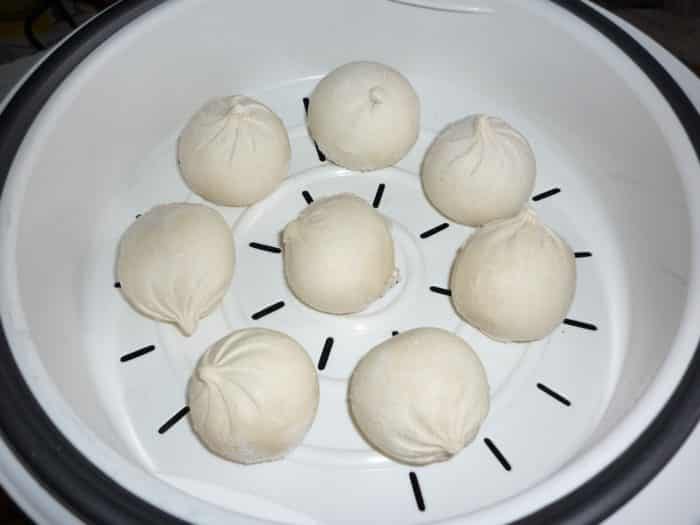
You can prepare a Georgian dish in both a slow cooker and a pressure cooker. The principle is the same: the state of readiness occurs under the influence of hot steam. It’s very easy to prepare Khinkali in a slow cooker:
- Pour clean, cold water into the bowl. The volume depends on the number of pieces: for one unit - 1/2 cup of liquid.
- The grate or stand must be greased with oil (both butter and sunflower oil are used);
- Khinkali is placed on the surface of a lattice (stand) so that they do not stick to each other;
- The appropriate mode is set, and the container is closed with a lid until complete cooking;
- After 30 minutes of waiting, the dish is ready.
True lovers of traditional Georgian cuisine do not accept steamed khinkali. This method is better suited for similar but different dishes. It has long been customary to prepare Kazakh manti using steam. Their dough is made thinner than in a Georgian dish, and the dough bag enveloping the filling is open.
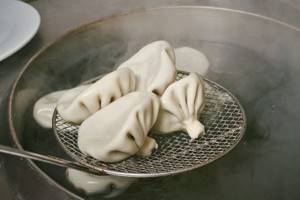
With this method, the khinkali dough becomes dense, and the dish itself loses its juiciness. Juiciness is one of the main criteria for a well-prepared Georgian dish.
How to cook khinkali on the stove
Initially, the pan in which the khinkali will be cooked is greased with butter. Only after this procedure can water be added. Thanks to these actions, the khinkali will not stick during cooking and will remain intact, the broth will not spill out and the products will remain juicy.
It is best to cook khinkali in a deep saucepan so that the water does not spill out when boiling. You need to fill the container ⅔ full with water, after which you need to add a little salt and then leave it on the fire until it boils.
We advise you to follow the following cooking rules to help make it as tasty as possible:
- place items in water one at a time to prevent them from sticking together;
- cook 12 khinkali in one batch, so they will not touch each other and will not stick together;
- freshly prepared products in the container must be constantly stirred: every minute for the first 5 minutes, then as needed, and after 10 minutes the pan is removed from the heat;
- frozen bags take about twenty minutes to prepare;;
- after 10 or 20 minutes of cooking, add 200-300 ml of cold water to the container and leave until it boils, after which you need to immediately turn off the heat and remove the pan from the heat.
Using a slotted spoon, remove the products from the container.
Traditions of serving dishes
This food, according to a long-established custom, is eaten with hands, holding each piece by the tail. Carefully bite into the dough bag to drink the broth inside. Then they eat the dough itself with the filling. It is customary to leave the tails on the plate.
Traditionally, khinkali is served with a variety of sauces: satsebeli or tkemali. Before serving, they must be poured with butter and seasoned with coarse black pepper. All this is very tasty, juicy and colorful.
As the French philosopher Paul Ricoeur said: “Every tradition lives through interpretation.”
There are many ways to bring delicious khinkali to readiness. If you want to enjoy real national cuisine and join the culture of Georgia, then the best way is to cook this dish the old fashioned way in an ordinary pan.
How to cook khinkali
Articles on the topic
- Beetroot with kefir for weight loss - recipes and reviews. Recipes for beetroot-kefir diet for weight loss
- What is DNA - deoxyribonucleic acid
- Treatment of high cholesterol - lowering drugs. How to treat high cholesterol using traditional methods
The whole process consists of four main stages: kneading the dough, processing the products for filling, forming the products and their heat treatment. Cooking khinkali is not the easiest task, so you should remember a few useful tips regarding the recipe for this tasty and tender dish:
- The dough is made from flour, with the addition of water and salt. According to the recipe, eggs are not added to the composition to make the mass denser and more elastic.
- For the filling, minced meat is used (it should be finely chopped) or minced meat passed through a meat grinder. It can consist of beef, pork, lamb, chicken. Be sure to add ingredients such as onions, water or broth.
- Sometimes the filling is made with vegetables, mushrooms or sweets with the addition of raisins, dried apricots, and nuts.
- In the minced meat recipe, to improve the taste, be sure to add more chopped herbs: parsley, dill, cilantro, spinach.
- It is very important to use the right blend of spices. Cumin, garlic, ground black pepper and peas, mint, coriander, and basil give the dish a unique aroma.
- Khinkali needs to be sculpted correctly. From a layer of dough rolled out a couple of millimeters thick, cut out circles with a diameter of 10-13 cm. Place minced meat in the middle of each of them. Then folds are formed from the edges. Then they need to be collected in a bag, wrapped and pinched.
- If you decide to boil the preparations not by steaming, but in water, salt it well so that they turn out tasty.
- Traditionally, the dish is eaten with hands. The bag is taken by the tail and bitten. First, they drink the rich meat juice that appears inside, and then eat the minced meat and dough.
- To prevent the workpieces from sticking together during cooking, the container you are going to use for cooking must be treated with oil. It is also recommended to add a teaspoon of cold water to boiling boiling water.
- Serve the dish with tomato or sour cream sauce and butter.
There are several ways to cook khinkali:
- steam processing (multi-cooker, double boiler);
- in boiling water (saucepan, microwave).
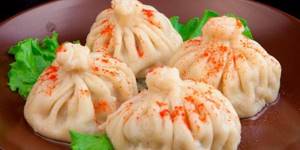
Khinkali in a slow cooker
This cooking method is one of the simplest. Khinkali is steamed in a slow cooker as follows:
- Pour from 500 to 700 ml of water into the device’s container (100 ml per piece).
- Grease the steam cooking grate with butter or vegetable oil. place it on the bowl.
- Place the bags so that they do not touch each other.
- Set the "Steam" function. Cook for half an hour with the appliance lid closed.
Steamed Khinkali
With this cooking method, the dough becomes denser. How to cook khinkali in a double boiler:
- Fill the device container with water to the maximum level.
- Treat the lower bowl of the steamer with oil. Place the pieces on it so that there is free space between them.
- Place the bowl on the appliance and cook the dish for 20-25 minutes.
If you don’t have a steamer, you can steam the bags using a saucepan:
- Take a sieve of the same diameter.
- Fill the pan three-quarters full with water. Boil it.
- Place the blanks on a sieve and place on a pan. Cover with a lid and cook for about 10 minutes.
Khinkali in the microwave
The fastest way. How to cook khinkali in the microwave:
- Place the blanks (5-6 pcs.) in a deep bowl suitable for a microwave oven.
- Pour in 0.25 liters of cool water, add salt and spices. Cover the container.
- Cook at highest power for 10-12 minutes.
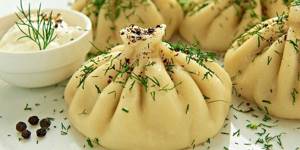
How to properly cook khinkali in a saucepan
If you don't have kitchen appliances like a slow cooker, steamer or microwave, you can still cook this dish. How to cook khinkali in water:
- Choose a wider pan. Before you start cooking khinkali, boil a large amount of water and add salt.
- Use a slotted spoon to make a funnel and lower the workpiece into it.
- Second method: hold the bag by the tail and move it through the water so that the dough boils. Release after five seconds.
- Third method: lower the workpiece with a spinning top, quickly unwinding it with your hand by the tail.
- The bags should be placed in one layer so that they do not stick together.
- The water should boil strongly; the pan should not be covered with a lid.
- When the workpieces are completely cooked, they will turn over with their tails down and float up. Typically this takes 13 to 15 minutes.
With lamb
Classic dough recipes do not include eggs, which, after boiling khinkali, make their shell look like pasta.

However, adding an egg component for subsequent freezing will have a positive effect on the integrity of the shell.
Composition of ingredients
To prepare the dish you will need:
- sunflower oil - 2 tsp;
- whole milk - 1 tbsp.;
- lamb - 300 g;
- premium flour - 4 tbsp;
- drinking water - ½ tbsp.;
- eggs - 2 pcs.;
- onions - 2 pcs.;
- salt, pepper, herbs - according to preference.
Step-by-step cooking process
The sequence of stages of creating food:
- First, you need to combine purified water and milk, add eggs scrambled with a fork and 1 tsp to the mixture. table salt.
- The resulting composition should be mixed, add sifted flour into it, then knead a stiff and elastic dough, gradually rubbing sunflower oil into it.
- The molded ball should be wrapped in film and left for 50–60 minutes. in the refrigerator.
- In the meantime, you need to wash the meat, divide the piece into pieces, then grind it in a home processor using the largest grid.
- The resulting mass must be seasoned with salt and pepper, add chopped herbs, then knead the products well, adding portions of drinking water.
- Now you need to take out the dough, roll it out into a thin layer, cut out circles in it, put the juicy filling on them, then form the khinkali in the usual manner.

- The resulting products can be immediately boiled or sent to the freezer.
- To prepare the semi-finished product, you need to get the required amount of frozen product, boil filtered water in a large and wide saucepan, salt the mixture, then put the batch into it, carefully lowering one khinkal into the seething liquid.
- After 1–2 min. You should use a spatula to make sure that the products do not stick to the bottom of the container, then continue the process for 10–15 minutes. from the beginning of a new boil.
The main condition for obtaining a tasty dish is not to overcook the food, so that the dough does not soften and remains al dente (with a slight crunch).

